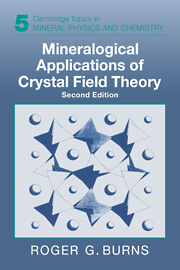Book contents
- Frontmatter
- Contents
- Preface to the first edition
- Preface to the second edition
- 1 Introduction
- 2 Outline of crystal field theory
- 3 Energy level diagrams and crystal field spectra of transition metal ions
- 4 Measurements of absorption spectra of minerals
- 5 Crystal field spectra of transition metal ions in minerals
- 6 Crystal chemistry of transition metal-bearing minerals
- 7 Thermodynamic properties influenced by crystal field energies
- 8 Trace element geochemistry: distribution of transition metals in the Earth's crust
- 9 Mantle geochemistry of the transition elements: optical spectra at elevated temperatures and pressures
- 10 Remote-sensing compositions of planetary surfaces: applications of reflectance spectra
- 11 Covalent bonding of the transition elements
- Appendices
- References
- Subject index
11 - Covalent bonding of the transition elements
Published online by Cambridge University Press: 23 November 2009
- Frontmatter
- Contents
- Preface to the first edition
- Preface to the second edition
- 1 Introduction
- 2 Outline of crystal field theory
- 3 Energy level diagrams and crystal field spectra of transition metal ions
- 4 Measurements of absorption spectra of minerals
- 5 Crystal field spectra of transition metal ions in minerals
- 6 Crystal chemistry of transition metal-bearing minerals
- 7 Thermodynamic properties influenced by crystal field energies
- 8 Trace element geochemistry: distribution of transition metals in the Earth's crust
- 9 Mantle geochemistry of the transition elements: optical spectra at elevated temperatures and pressures
- 10 Remote-sensing compositions of planetary surfaces: applications of reflectance spectra
- 11 Covalent bonding of the transition elements
- Appendices
- References
- Subject index
Summary
Theories of chemical bonding – – fall into one of two categories: those which are too good to be true and those which are too true to be good.
F. A. Cotton, J. Chem. Educ., 41, 475 (1964).Introduction
In earlier chapters, allusions were made to the effects of covalent bonding. For example, covalent interactions were invoked to account for the intensification of absorption bands in crystal field spectra when transition metal ions occupy tetrahedral sites (3.7.1); patterns of cation ordering for some transition metal ions in silicate crystal structures imply that covalency influences the intracrystalline (or intersite) partitioning of these cations (6.8.4); and, the apparent failure of the Goldschmidt Rules to accurately predict the fractionation of transition elements during magmatic crystallization was attributed to covalent bonding characteristics of these cations (8.3.2).
A fundamental assumption underlying the crystal field model of chemical bonding is that ligands may be treated as point negative charges with no overlap of metal and ligand orbitals. Thus, 3d electrons are assumed to remain entirely on the transition metal ion with no delocalization into ligand orbitals. This situation is never realized, even in ionic structures such as periclase (MgO) and forsterite (Mg2SiO4), let alone bunsenite (NiO), liebenbergite (Ni2SiO4) or fayalite (Fe2SiO4), in which metal–oxygen bonds have some degree of covalent character and electrons in metal orbitals participate in the bonding. Some of the fundamental features of crystal field theory are contrary to expectation or are impossible to derive using the point charge model (Cotton, 1964).
- Type
- Chapter
- Information
- Mineralogical Applications of Crystal Field Theory , pp. 428 - 459Publisher: Cambridge University PressPrint publication year: 1993



